Investigation of Slow-Moving Artificial Slope Failure with Multi-Temporal InSAR by Combining Persistent and Distributed Scatterers: A Case Study in Northern Taiwan
Abstract
1. Introduction
2. Study Area and Datasets
2.1. Geological Setting and Evolution of the Freeway No. 3 Landslide
2.1.1. Geological Setting and Local Climate
2.1.2. The Landslide
2.2. Satellite SAR Data
3. Methodology
3.1. Coherent Point Selection
3.2. Interval Phase Estimation
3.3. Systematic Error Correction
4. Results
4.1. Phase Reconstruction and Systematic Error Correction
4.2. Spatial Pattern and Temporal Behavior of Slope Movement
5. Discussion
5.1. Interpretation of the Freeway No. 3 Landslide Movement
5.2. Correlation with Rainfall
5.3. Performance of InSAR Technique on Detecting and Monitoring Landslides
- Coherent point selection: although PS has stable scatterering behavior over long-term periods, the sparse distribution of PS in rural areas compromises the efficiency of landslide displacement retrieval. To increase the density of coherent measurements, not only PS points are included in the processing analysis, but also DS points, which are widely distributed in mountainous regions and correspond to ground targets with high sensitivity to spatial and temporal baselines.
- Interval phase estimation: the objective of this procedure is to obtain sufficient optimized phase measurements, which involves phase denoising and phase unwrapping. In traditional processing flow, phase denoising and phase unwrapping are carried out separately (e.g., phase denoising is achieved by phase triangulation [33], while phase unwrapping is implemented by minimum cost flow (MCF) [51]). However, the separated processes will introduce extra estimation error due to necessary approximations and presumptions in each step [52]. On the contrary, in this study, we apply an arc-based phase estimation approach to jointly conduct phase denoising and phase unwrapping. The linear formulation via this method ensures the estimation efficiency and quality of the phase optimization.
- Systematic error correction: Multiple error sources exist in phase measurements despite the implementation of phase optimization. In this study, topographic residual and height-dependent atmospheric delays are the most prominent (Figure 6). The component-based method provides an efficient way to correct the topographic residual without requiring a priori deformation model. Although the joint model is time-consuming, it simultaneously estimates height-dependent atmospheric delays, orbital error and deformation signal, avoiding estimation bias caused by confounding processes [47].
6. Conclusions
Author Contributions
Funding
Acknowledgments
Conflicts of Interest
References
- Wasowski, J.; Bovenga, F. Remote Sensing of Landslide Motion with Emphasis on Satellite Multitemporal Interferometry Applications. In Landslide Hazards, Risks and Disasters; Elsevier BV: Amsterdam, The Netherlands, 2015; pp. 345–403. [Google Scholar]
- Ochiai, H.; Sammori, T.; Okada, Y. Landslide Experiments on Artificial and Natural Slopes. In Progress in Landslide Science; Springer Science and Business Media LLC: Berlin, Germany, 2007; pp. 209–226. [Google Scholar]
- Liao, H.J.; Lee, W.F. Forensic Study on the Dip Slope Failure of Freeway No.3 at Chainage 3.1K. J. Perform. Constr. Facil. 2011, 27, 116–131. [Google Scholar] [CrossRef]
- Lee, W.F.; Liao, H.J.; Chang, M.H.; Wang, C.W.; Chi, S.Y.; Lin, C.C. Failure Analysis of a Highway Dip Slope Slide. J. Perform. Constr. Facil. 2013, 27, 116–131. [Google Scholar] [CrossRef]
- Sun, Q.; Zhang, L.; Ding, X.; Hu, J.; Li, Z.; Zhu, J. Slope deformation prior to Zhouqu, China landslide from InSAR time series analysis. Remote. Sens. Environ. 2015, 156, 45–57. [Google Scholar] [CrossRef]
- Tong, X.; Schmidt, D. Active movement of the Cascade landslide complex in Washington from a coherence-based InSAR time series method. Remote. Sens. Environ. 2016, 186, 405–415. [Google Scholar] [CrossRef]
- Dai, K.; Li, Z.; Xu, Q.; Burgmann, R.; Milledge, D.G.; Tomas, R.; Fan, X.; Zhao, C.; Liu, X.; Peng, J.; et al. Entering the Era of Earth Observation-Based Landslide Warning Systems: A Novel and Exciting Framework. IEEE Geosci. Remote. Sens. Mag. 2020, 8, 136–153. [Google Scholar] [CrossRef]
- Carlà, T.; Intrieri, E.; Raspini, F.; Bardi, F.; Farina, P.; Ferretti, A.; Colombo, D.; Novali, F.; Casagli, N. Perspectives on the prediction of catastrophic slope failures from satellite InSAR. Sci. Rep. 2019, 9, 14137–14139. [Google Scholar] [CrossRef]
- Massonnet, D.; Feigl, K.L. Radar interferometry and its application to changes in the Earth’s surface. Rev. Geophys. 1998, 36, 441–500. [Google Scholar] [CrossRef]
- Hanssen, R.F. Radar Interferometry: Data Interpretation and Error Analysis; Earth and Environmental Science Kluwer Academic Publishers: Dordrecht, The Netherlands, 2001; Volume 2, p. 308. [Google Scholar]
- Ferretti, A.; Prati, C.; Rocca, F. Permanent scatterers in SAR interferometry. IEEE Trans. Geosci. Remote. Sens. 2001, 39, 8–20. [Google Scholar] [CrossRef]
- Hooper, A.; Segall, P.; Zebker, H. Persistent scatterer interferometric synthetic aperture radar for crustal deformation analysis, with application to Volcán Alcedo, Galápagos. J. Geophys. Res. Space Phys. 2007, 112, B07407. [Google Scholar] [CrossRef]
- Kampes, B.M. Radar Interferometry: Persistent Scatterer Technique; Springer: Dordrecht The Netherlands, 2006. [Google Scholar]
- Costantini, M.; Falco, S.; Malvarosa, F.; Minati, F.; Trillo, F.; Vecchioli, F. Persistent Scatterer Pair Interferometry: Approach and Application to COSMO-SkyMed SAR Data. IEEE J. Sel. Top. Appl. Earth Obs. Remote. Sens. 2014, 7, 2869–2879. [Google Scholar] [CrossRef]
- Berardino, P.; Fornaro, G.; Lanari, R.; Sansosti, E. A new algorithm for surface deformation monitoring based on small baseline differential SAR interferograms. IEEE Trans. Geosci. Remote. Sens. 2002, 40, 2375–2383. [Google Scholar] [CrossRef]
- Schmidt, D.A.; Bürgmann, R. Time-dependent land uplift and subsidence in the Santa Clara valley, California, from a large interferometric synthetic aperture radar data set. J. Geophys. Res. Space Phys. 2003, 108, 2416. [Google Scholar] [CrossRef]
- Lanari, R.; Mora, O.; Manunta, M.; Mallorqui, J.J.; Berardino, P.; Sansosti, E. A small-baseline approach for investigating deformations on full-resolution differential SAR interferograms. IEEE Trans. Geosci. Remote. Sens. 2004, 42, 1377–1386. [Google Scholar] [CrossRef]
- Zhang, L.; Lu, Z.; Ding, X.; Jung, H.-S.; Feng, G.; Lee, C.-W. Mapping ground surface deformation using temporarily coherent point SAR interferometry: Application to Los Angeles Basin. Remote. Sens. Environ. 2012, 117, 429–439. [Google Scholar] [CrossRef]
- Ma, P.; Lin, H. Robust Detection of Single and Double Persistent Scatterers in Urban Built Environments. IEEE Trans. Geosci. Remote. Sens. 2015, 54, 2124–2139. [Google Scholar] [CrossRef]
- Gernhardt, S.; Bamler, R. Deformation monitoring of single buildings using meter-resolution SAR data in PSI. ISPRS J. Photogramm. Remote. Sens. 2012, 73, 68–79. [Google Scholar] [CrossRef]
- Fialko, Y. Evidence of fluid-filled upper crust from observations of postseismic deformation due to the 1992Mw7.3 Landers earthquake. J. Geophys. Res. Space Phys. 2004, 109, 08401. [Google Scholar] [CrossRef]
- Lu, Z.; Dzurisin, D. InSAR Imaging of Aleutian Volcanoes; Springer Science and Business Media LLC: Berlin, Germany, 2014; pp. 87–345. [Google Scholar]
- Gong, W.; Darrow, M.M.; Meyer, F.J.; Daanen, R.P. Reconstructing movement history of frozen debris lobes in northern Alaska using satellite radar interferometry. Remote. Sens. Environ. 2019, 221, 722–740. [Google Scholar] [CrossRef]
- Qu, F.; Lu, Z.; Zhang, Q.; Bawden, G.W.; Kim, J.-W.; Zhao, C.; Qu, W. Mapping ground deformation over Houston–Galveston, Texas using multi-temporal InSAR. Remote. Sens. Environ. 2015, 169, 290–306. [Google Scholar] [CrossRef]
- Dong, J.; Zhang, L.; Tang, M.; Liao, M.; Xu, Q.; Gong, J.; Ao, M. Mapping landslide surface displacements with time series SAR interferometry by combining persistent and distributed scatterers: A case study of Jiaju landslide in Danba, China. Remote. Sens. Environ. 2018, 205, 180–198. [Google Scholar] [CrossRef]
- Dai, K.; Li, Z.; Tomás, R.; Liu, G.; Yu, B.; Wang, X.; Cheng, H.; Chen, J.; Stockamp, J. Monitoring activity at the Daguangbao mega-landslide (China) using Sentinel-1 TOPS time series interferometry. Remote. Sens. Environ. 2016, 186, 501–513. [Google Scholar] [CrossRef]
- Wasowski, J.; Bovenga, F. Investigating landslides and unstable slopes with satellite Multi Temporal Interferometry: Current issues and future perspectives. Eng. Geol. 2014, 174, 103–138. [Google Scholar] [CrossRef]
- Zhang, L.; Ding, X.; Lu, Z. Ground deformation mapping by fusion of multi-temporal interferometric synthetic aperture radar images: A review. Int. J. Image Data Fusion 2015, 6, 1–25. [Google Scholar] [CrossRef]
- Chen, C.-W.; Tung, Y.-S.; Liou, J.-J.; Li, H.-C.; Cheng, C.-T.; Chen, Y.-M.; Oguchi, T. Assessing landslide characteristics in a changing climate in northern Taiwan. Catena 2019, 175, 263–277. [Google Scholar] [CrossRef]
- Chen, H.; Dadson, S.; Chi, Y.-G. Recent rainfall-induced landslides and debris flow in northern Taiwan. Geomorphology 2006, 77, 112–125. [Google Scholar] [CrossRef]
- Chen, L.-K.; Chen, S.-C.; Ke, M.-C. Investigation of the Freeway No. 3 Landslide in Taiwan. In Engineering Geology for Society and Territory—Volume 2; Springer Science and Business Media LLC: Berlin, Germany, 2015; pp. 2093–2096. [Google Scholar]
- Tadono, T.; Ishida, H.; Oda, F.; Naito, S.; Minakawa, K.; Iwamoto, H. Precise Global DEM Generation by ALOS PRISM. ISPRS Ann. Photogramm. Remote. Sens. Spat. Inf. Sci. 2014, 71–76. [Google Scholar] [CrossRef]
- Ferretti, A.; Fumagalli, A.; Novali, F.; Prati, C.; Rocca, F.; Rucci, A. A New Algorithm for Processing Interferometric Data-Stacks: SqueeSAR. IEEE Trans. Geosci. Remote. Sens. 2011, 49, 3460–3470. [Google Scholar] [CrossRef]
- Wang, Y.; Zhu, X.X.; Bamler, R. Retrieval of phase history parameters from distributed scatterers in urban areas using very high resolution SAR data. ISPRS J. Photogramm. Remote. Sens. 2012, 73, 89–99. [Google Scholar] [CrossRef]
- Jiang, M.; Ding, X.; Hanssen, R.F.; Malhotra, R.; Chang, L. Fast Statistically Homogeneous Pixel Selection for Covariance Matrix Estimation for Multitemporal InSAR. IEEE Trans. Geosci. Remote. Sens. 2014, 53, 1213–1224. [Google Scholar] [CrossRef]
- González, P.J.; Fernández, J. Error estimation in multitemporal InSAR deformation time series, with application to Lanzarote, Canary Islands. J. Geophys. Res. Space Phys. 2011, 116, B10404. [Google Scholar] [CrossRef]
- Zhang, L.; Ding, X.; Lu, Z. Modeling PSInSAR Time Series Without Phase Unwrapping. IEEE Trans. Geosci. Remote. Sens. 2010, 49, 547–556. [Google Scholar] [CrossRef]
- Liang, H.; Zhang, L.; Ding, X.; Lu, Z.; Li, X.; Hu, J.; Wu, S. Suppression of Coherence Matrix Bias for Phase Linking and Ambiguity Detection in MTInSAR. IEEE Trans. Geosci. Remote. Sens. 2020, 1–12. [Google Scholar] [CrossRef]
- Yang, Y.; Song, L.; Xu, T. Robust estimator for correlated observations based on bifactor equivalent weights. J. Geod. 2002, 76, 353–358. [Google Scholar] [CrossRef]
- Samiei-Esfahany, S.; Martins, J.E.; Van Leijen, F.; Hanssen, R.F. Phase Estimation for Distributed Scatterers in InSAR Stacks Using Integer Least Squares Estimation. IEEE Trans. Geosci. Remote. Sens. 2016, 54, 5671–5687. [Google Scholar] [CrossRef]
- Andersen, R. Modern Methods for Robust Regression; SAGE Publications: Thousand Oaks, CA, USA, 2008. [Google Scholar] [CrossRef]
- Huber, P.J.; Ronchetti, E.M. Robust Statistics; Wiley: New York, NY, USA, 2009. [Google Scholar]
- Pepe, A.; Lanari, R. On the Extension of the Minimum Cost Flow Algqorithm for Phase Unwrapping of Multitemporal Differential SAR Interferograms. IEEE Trans. Geosci. Remote. Sens. 2006, 44, 2374–2383. [Google Scholar] [CrossRef]
- Du, Y.; Zhang, L.; Feng, G.; Lu, Z.; Sun, Q. On the Accuracy of Topographic Residuals Retrieved by MTInSAR. IEEE Trans. Geosci. Remote. Sens. 2016, 55, 1053–1065. [Google Scholar] [CrossRef]
- Liang, H.; Zhang, L.; Lu, Z.; Li, X. Nonparametric Estimation of DEM Error in Multitemporal InSAR. IEEE Trans. Geosci. Remote. Sens. 2019, 57, 10004–10014. [Google Scholar] [CrossRef]
- Liang, H.; Zhang, L.; Ding, X.; Lu, Z.; Li, X. Toward Mitigating Stratified Tropospheric Delays in Multitemporal InSAR: A Quadtree Aided Joint Model. IEEE Trans. Geosci. Remote. Sens. 2018, 57, 291–303. [Google Scholar] [CrossRef]
- Zhang, L.; Ding, X.; Lu, Z.; Jung, H.-S.; Hu, J.; Feng, G. A Novel Multitemporal InSAR Model for Joint Estimation of Deformation Rates and Orbital Errors. IEEE Trans. Geosci. Remote. Sens. 2013, 52, 3529–3540. [Google Scholar] [CrossRef]
- Handwerger, A.L.; Roering, J.J.; Schmidt, D.A. Controls on the seasonal deformation of slow-moving landslides. Earth Planet. Sci. Lett. 2013, 377, 239–247. [Google Scholar] [CrossRef]
- Iverson, R.M.; Major, J.J. Rainfall, ground-water flow, and seasonal movement at Minor Creek landslide, northwestern California: Physical interpretation of empirical relations. GSA Bull. 1987, 99, 579. [Google Scholar] [CrossRef]
- Fell, R.; Corominas, J.; Bonnard, C.; Cascini, L.; Leroi, E.; Savage, W.Z. Guidelines for landslide susceptibility, hazard and risk zoning for land-use planning. Eng. Geol. 2008, 102, 99–111. [Google Scholar] [CrossRef]
- Constantini, M. A novel phase unwrapping method based on network programming. IEEE Trans. Geosci. Remote. Sens. 1998, 36, 813–821. [Google Scholar] [CrossRef]
- Chen, R.; Yu, W.; Wang, R.; Liu, G.; Shao, Y. Integrated Denoising and Unwrapping of InSAR Phase Based on Markov Random Fields. IEEE Trans. Geosci. Remote. Sens. 2013, 51, 4473–4485. [Google Scholar] [CrossRef]
- Jia, H.; Wang, Y.; Ge, D.; Deng, Y.; Wang, R. Improved offset tracking for predisaster deformation monitoring of the 2018 Jinsha River landslide (Tibet, China). Remote Sens. Environ. 2020, 247. [Google Scholar] [CrossRef]
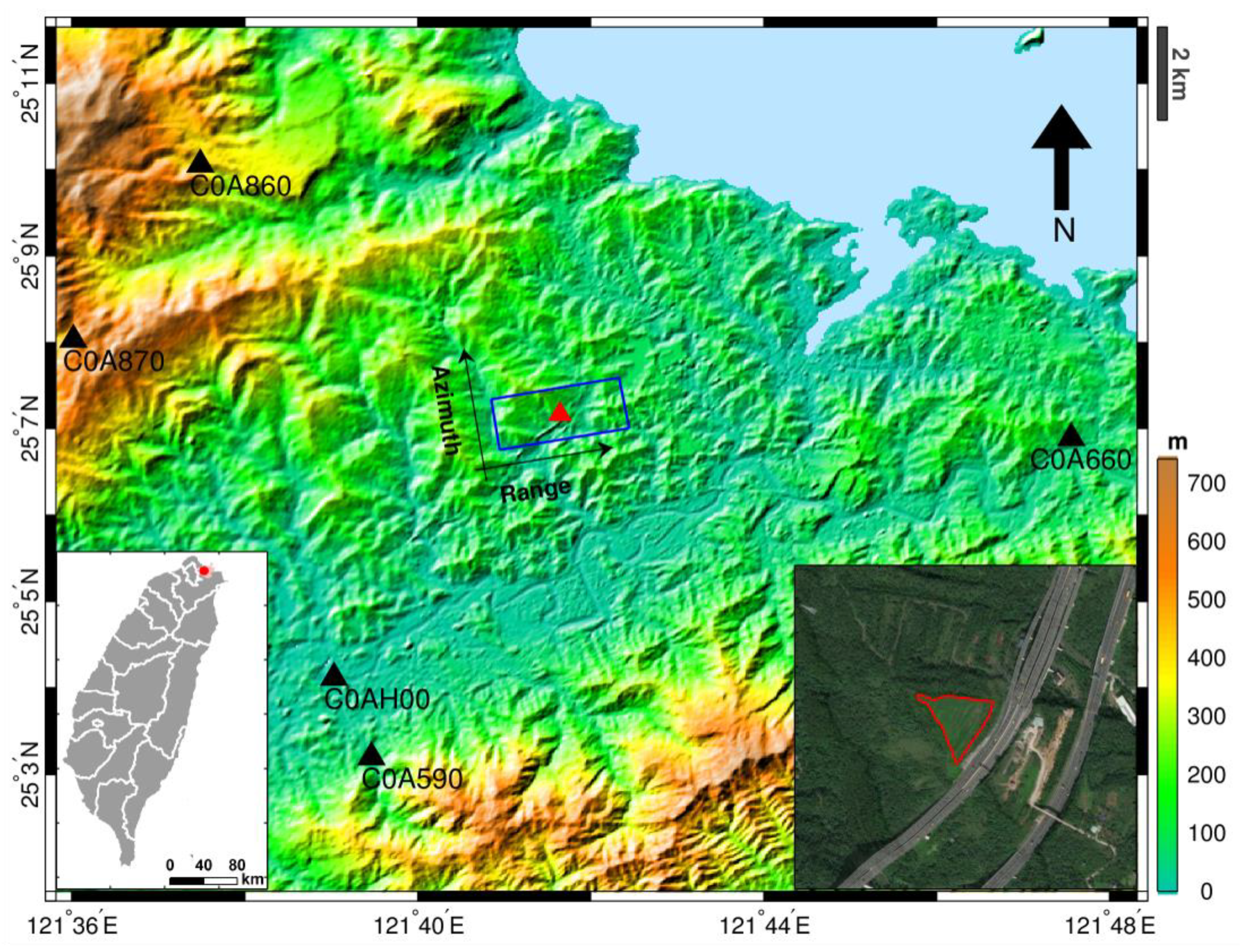
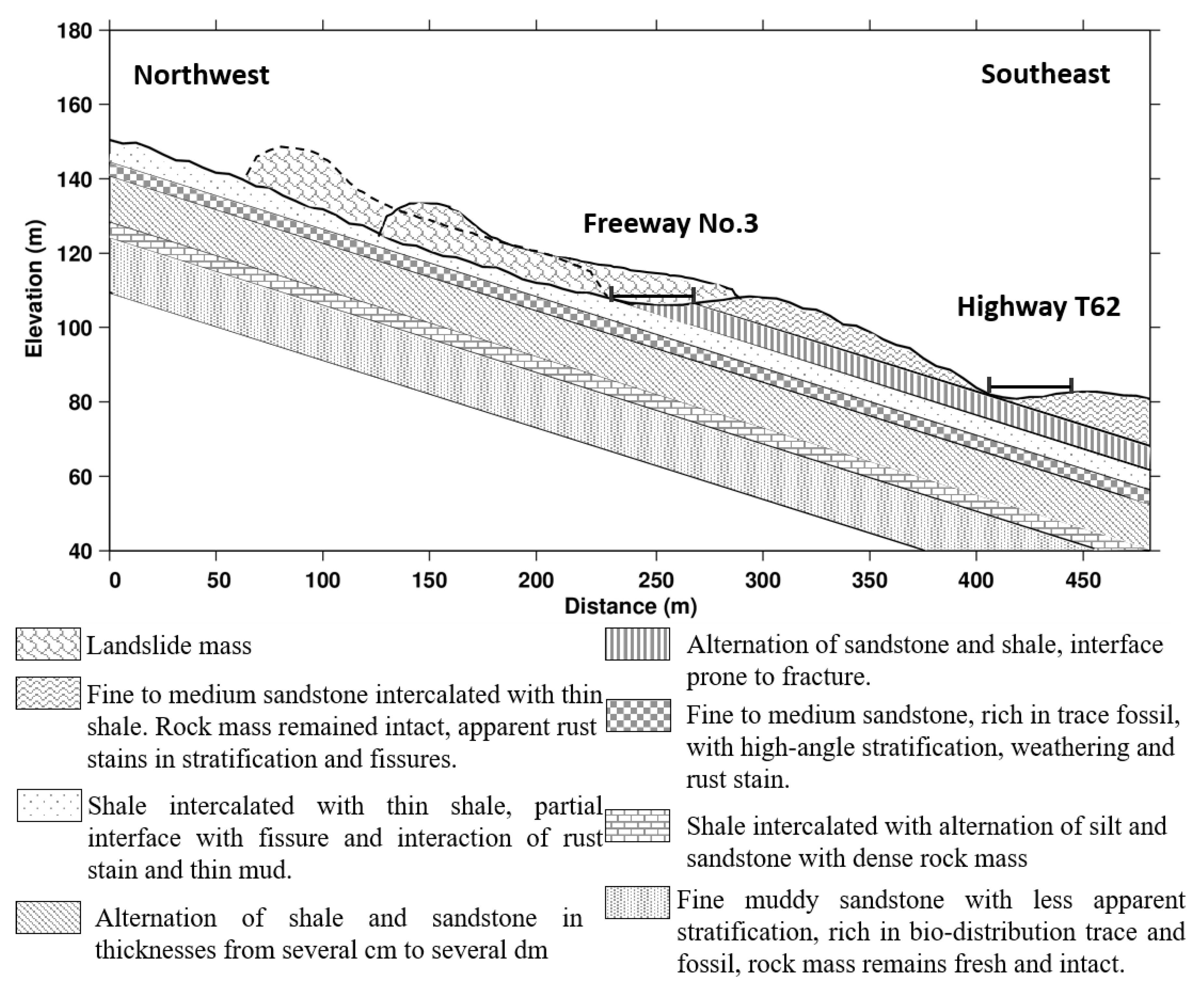
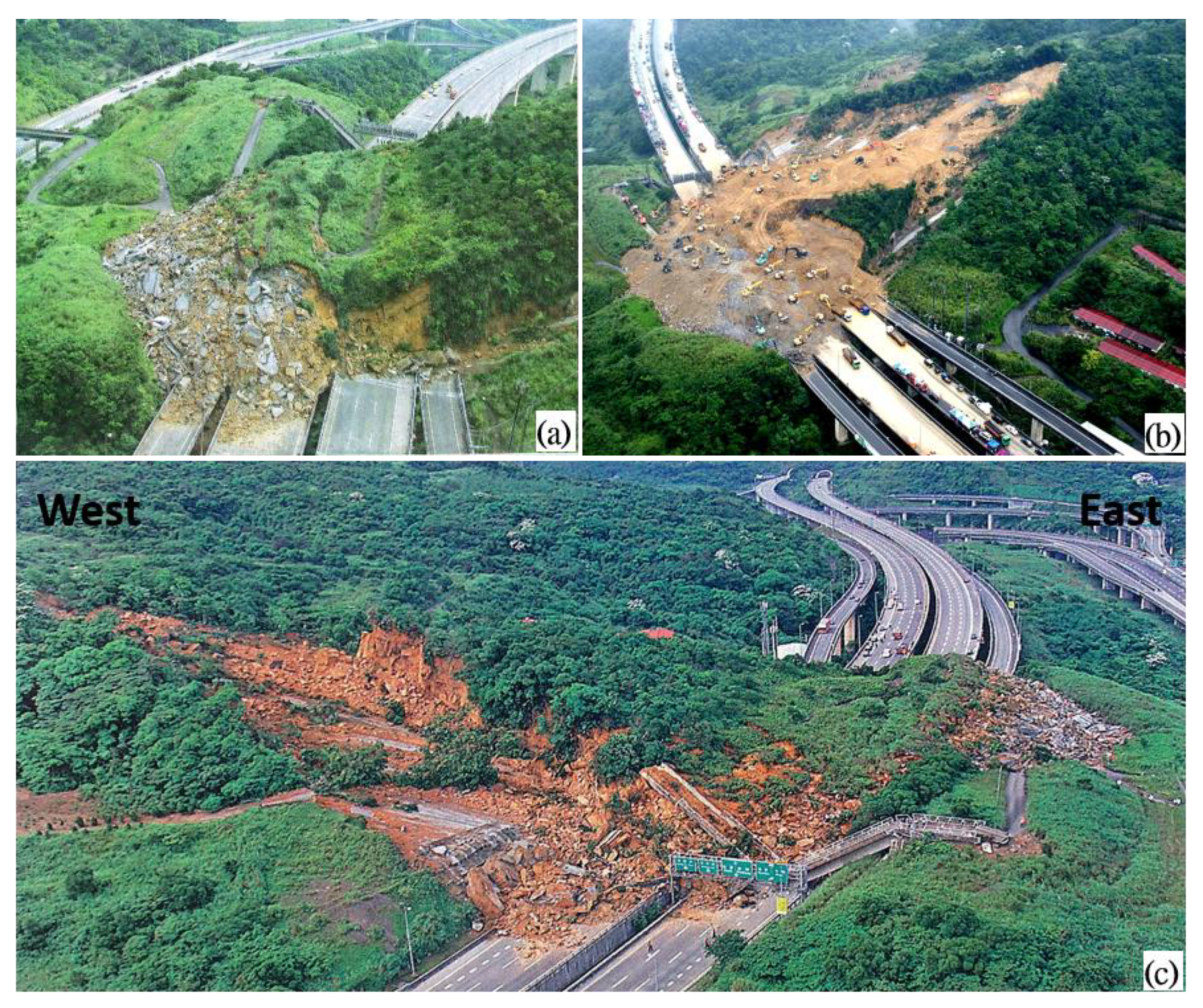

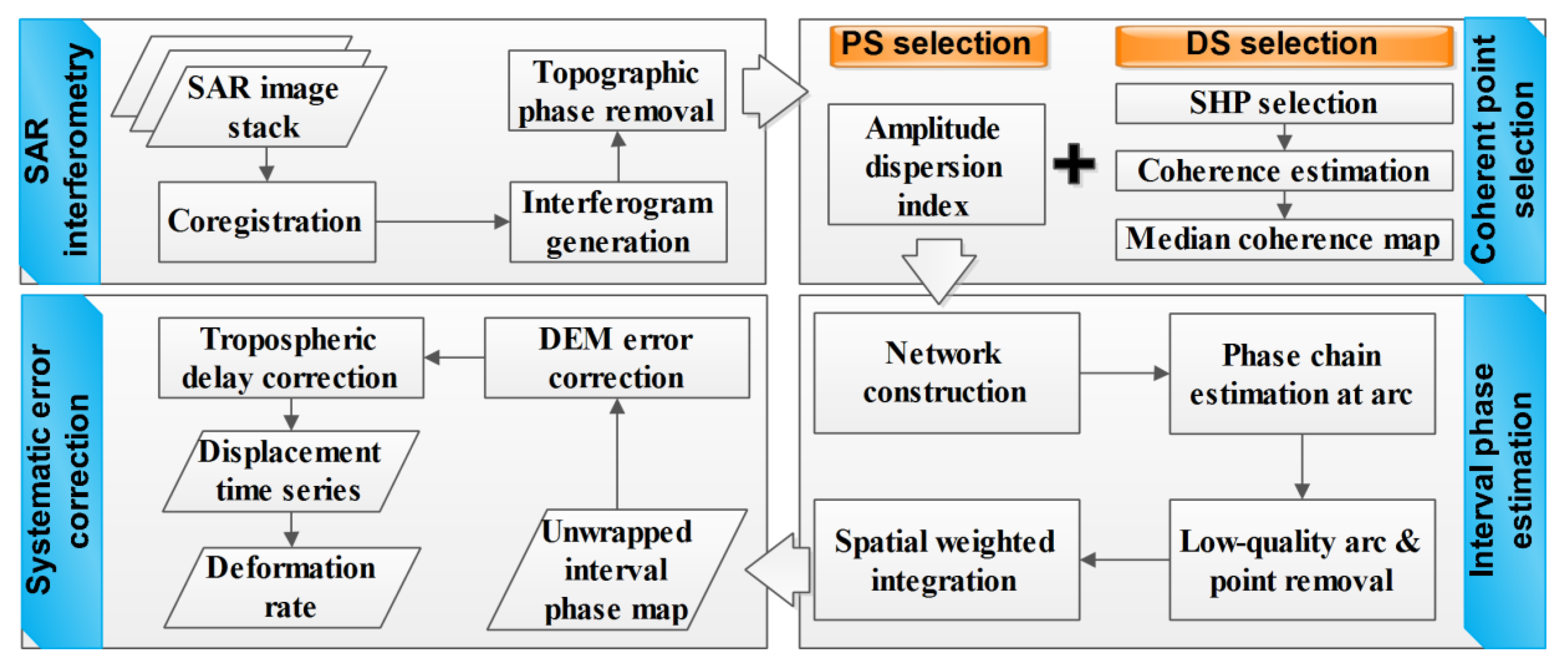

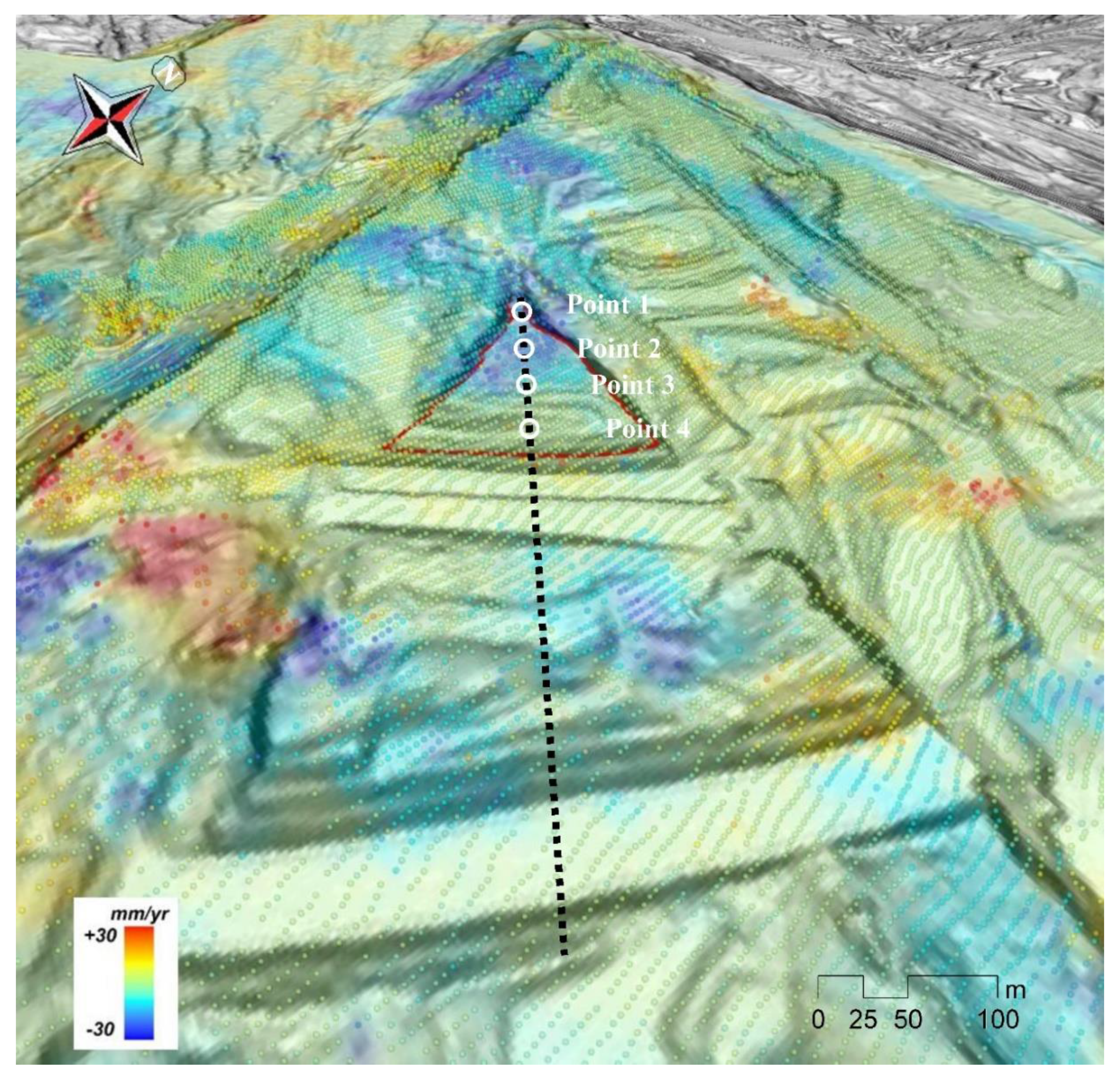
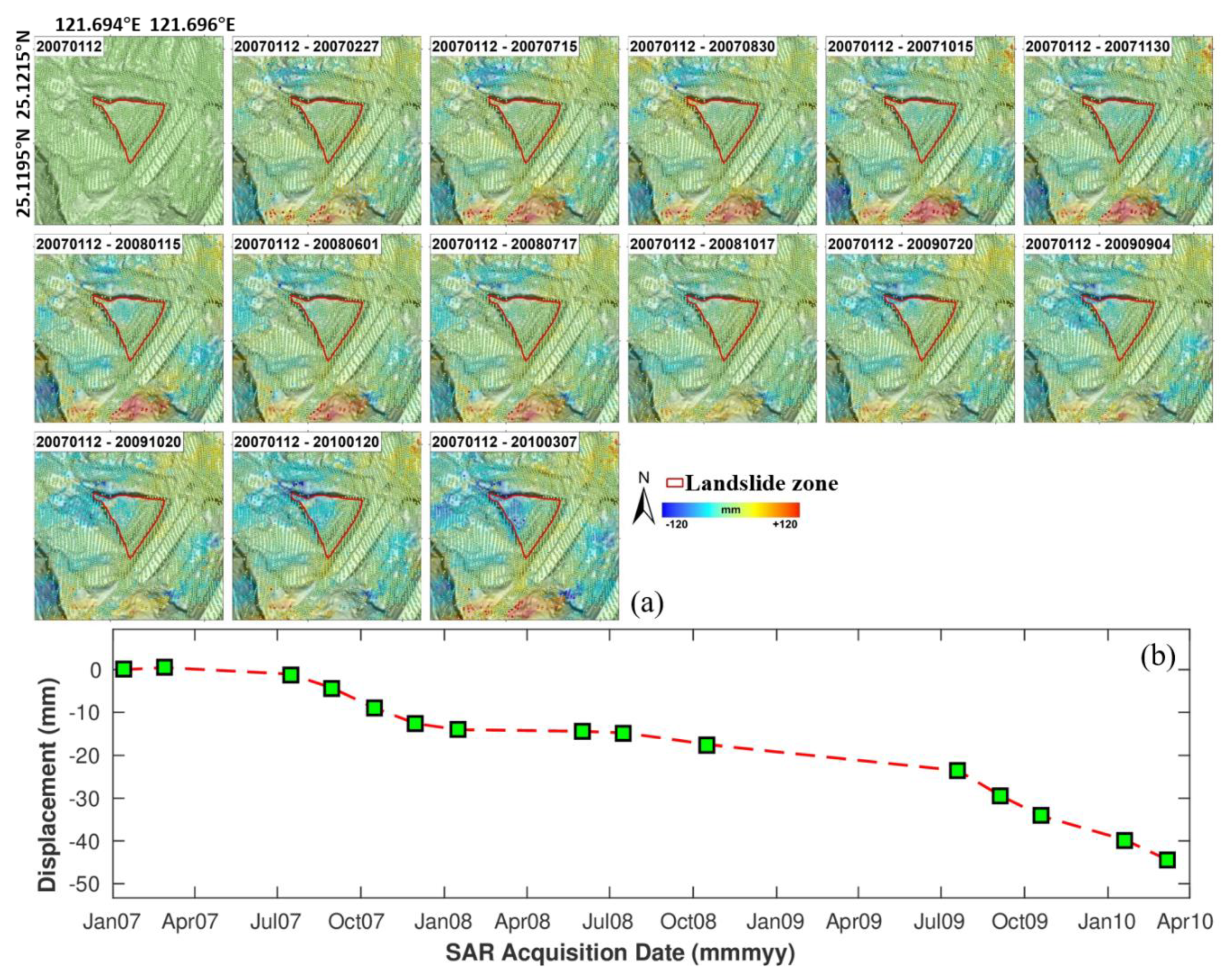

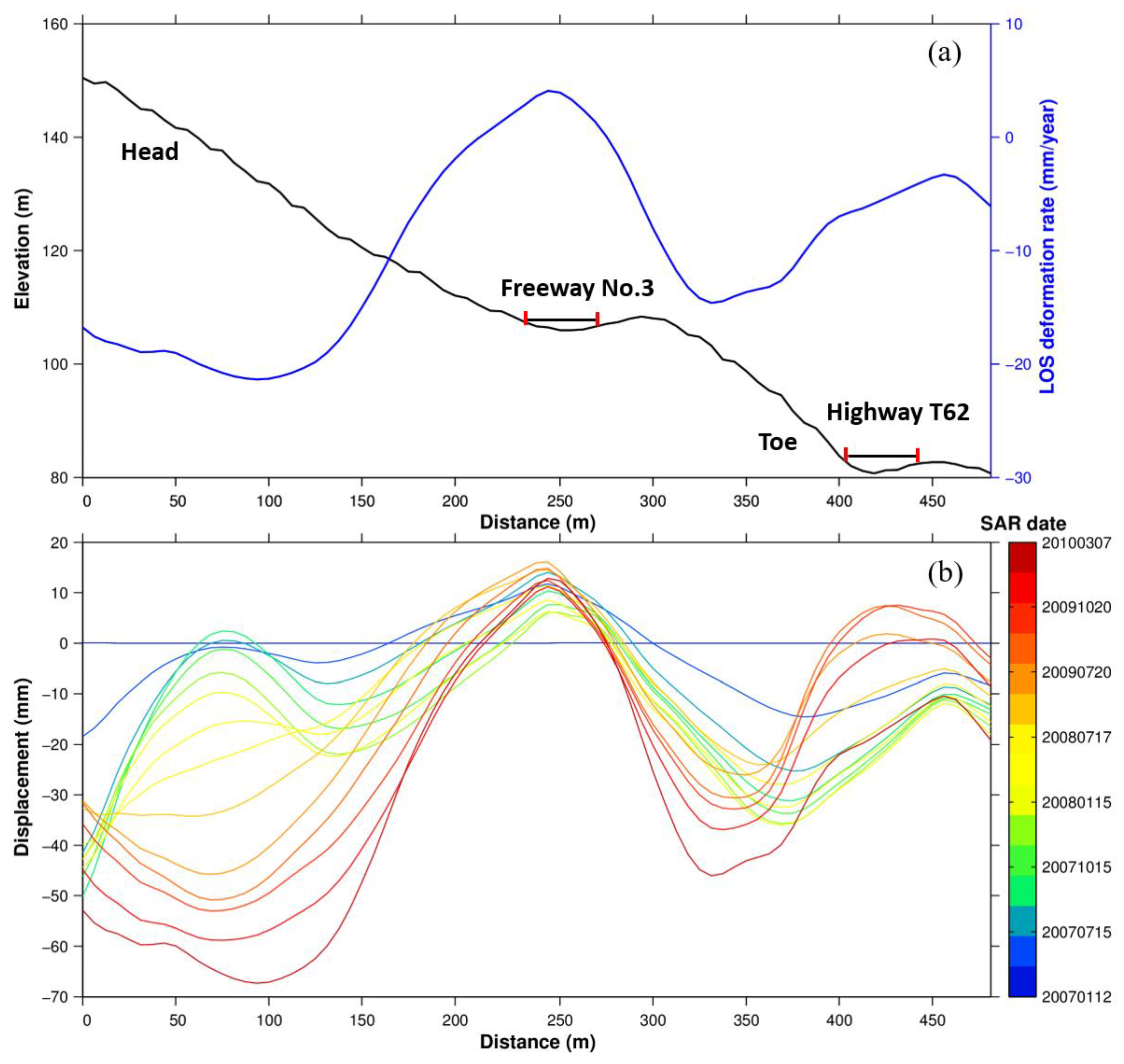

© 2020 by the authors. Licensee MDPI, Basel, Switzerland. This article is an open access article distributed under the terms and conditions of the Creative Commons Attribution (CC BY) license (http://creativecommons.org/licenses/by/4.0/).
Share and Cite
Liang, H.; Li, X.; Zhang, L.; Chen, R.-F.; Ding, X.; Chen, K.-L.; Wang, C.-S.; Chang, C.-S.; Chi, C.-Y. Investigation of Slow-Moving Artificial Slope Failure with Multi-Temporal InSAR by Combining Persistent and Distributed Scatterers: A Case Study in Northern Taiwan. Remote Sens. 2020, 12, 2403. https://doi.org/10.3390/rs12152403
Liang H, Li X, Zhang L, Chen R-F, Ding X, Chen K-L, Wang C-S, Chang C-S, Chi C-Y. Investigation of Slow-Moving Artificial Slope Failure with Multi-Temporal InSAR by Combining Persistent and Distributed Scatterers: A Case Study in Northern Taiwan. Remote Sensing. 2020; 12(15):2403. https://doi.org/10.3390/rs12152403
Chicago/Turabian StyleLiang, Hongyu, Xin Li, Lei Zhang, Rou-Fei Chen, Xiaoli Ding, Kuo-Long Chen, Chi-Shan Wang, Chia-Shin Chang, and Chien-Yu Chi. 2020. "Investigation of Slow-Moving Artificial Slope Failure with Multi-Temporal InSAR by Combining Persistent and Distributed Scatterers: A Case Study in Northern Taiwan" Remote Sensing 12, no. 15: 2403. https://doi.org/10.3390/rs12152403
APA StyleLiang, H., Li, X., Zhang, L., Chen, R.-F., Ding, X., Chen, K.-L., Wang, C.-S., Chang, C.-S., & Chi, C.-Y. (2020). Investigation of Slow-Moving Artificial Slope Failure with Multi-Temporal InSAR by Combining Persistent and Distributed Scatterers: A Case Study in Northern Taiwan. Remote Sensing, 12(15), 2403. https://doi.org/10.3390/rs12152403






